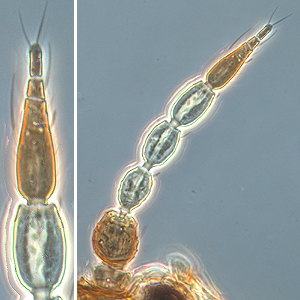Figures
Fig. 1: Antenna (inset: V.-VIII. (IX). antennal segment)
Fig. 2: Head dorsal with ocellar triangle
Fig. 3: Pronotum
Fig. 4: Meso- and metanotum
Fig. 5: Metathoracic furca
Fig. 6: Forewing
Fig. 7: Tergites V-VII
Fig. 8: Tergites VII and VIII
Taxonomic Information
Species:
Dendrothrips ornatus (Jablonowski, 1894)
Synonyms:
Dendrothrips schillei Bagnall, 1930
Dendrothrips ornatus var. schillei Bagnall, 1927
Dendrothrips adusta Priesner, 1926
Dendrothrips tiliae Uzel, 1895
Thrips ornata Jablonowski, 1894
Common name:
Privet thrips
Present taxonomic position:
Family: Thripidae Stephens, 1829
Subfamily: Dendrothripinae Priesner, 1925
Genus: Dendrothrips Uzel, 1895
Species Recognition
General information about the genus Dendrothrips:There are about 45 species currently known within this genus all having multifaceted body sculpture, have a lyre-shaped metothoracic furca, actively dispurse when disturbed and most can be found on small woody plants similar to olive (Mound and Kibby, 1998).
Typical character states of Dendrothrips ornatus:
Body color
Mainly brown
Antennae
Number of antennal segments: 8-9
Segment IV - forked sensorium: scarcely extending beyond base of segment V
Segments II and III shape: more or less symmetric
Segments III & IV sensoria: emergent and forked
Base of sensorium on antennal segment VI: no more than 2 times as wide as base of nearest seta
Terminal antennal segments: rarely elongate
Head:
Distance between bases of ocellar setae III: greater than width of first ocellus
Head shape between compound eyes: not prolonged
Ocellar setae III on head: arising on anterior margin of, or in front of, ocellar triangle
Surface of head, pronotum and fore legs: without strong reticulate sculpture
Ocellar setae I in front of anterior ocellus: absent
Prothorax
Number of pairs of elongate pronotal setae: 0-3
Number of pairs of elongate posteroangular pronotal setae: 0
Pronotum shape: rectangular
Mesothorax
Mesothoracic endofurca: with median spinula
Metathorax
Metanotal median area sculptured lines: transverse at anterior, but forming irregular longitudinal reticulations on posterior half
Metanotal median setae length: shorter than lateral metanotal setae
Metanotal median setae position: arising behind anterior margin
Metanotum: with campaniform sensilla
Metanotum major sclerite: with two major sclerites, metascutum and metascutellum
Metanotum median area: with no equiangular reticulation
Metanotum sculpture: without dominant sculptured triangle medially
Metathoracic endofurca: elongate and lyre-shape
Wings
Wings: present and more than half as long as abdomen
First vein of forewing: distinct from costal vein
Forewing anterior margin: with setae and cilia but cilia longer than setae
Forewing color: alternating bands of dark and light
Forewing costal fringe of cilia: arising ventrally behind anterior margin
Forewing costal setae at middle of wing: shorter than median width of wing
Forewing first vein setal row: incomplete, with setae not closely and uniformly spaced
Forewing posterior margin cilia: undulated near apex
Forewing second vein setal row: with no setae
Forewing surface: not reticulate
Forewings: with veins, setae and microtrichia
Legs
Fore tibial apex: not extending around fore tarsus
Mid and hind tarsi: with two segments
Abdomen:
Abdominal segment X: never tubular, longitudinally incomplete ventrally in both sexes
Abdominal sternite II: with marginal setae but no discal setae
Abdominal sternite III of female: without glandular areas
Abdominal sternite VII: with marginal setae but no discal setae
Abdominal sternite VII median marginal setae: arising at margin
Abdominal sternites IV , V and VI: with marginal setae but no discal setae
Abdominal tergites: without curved wing-retaining setae
Abdominal tergites IV & V median setal pair: longer than distance between their bases
Abdominal tergites V-VII: without paired ctenidia, sometimes with irregular microtrichia
Setae on abdominal tergite X: slender
Surface of lateral thirds of abdominal tergites: without regular rows of fine microtrichia
Ctenidia on tergite VIII: not present, but groups of microtrichia
Tergite VIII posteromarginal comb of microtrichia: present, complete medially
Tergite VIII posteromarginal microtrichia: short and irregular in length
Biology
Life history:
As with other thrips species the life cycle from egg to adult is dependent on temperature. The full cycle can take less than one week to over a month and adults may live for more than one month producing several generations in one year depending on seasonal weather (Lewis, 1973).
Host plants:
Syringa, Ligustrum, Alnus, Tilia,
Salix, Acer, Fraxinus (Oleaceae).
Vector capacity:
None identified
Current known distribution:
Europe, North America
Additional notes:
This species is probably one of the most handsome thrips known, unfortunately it is also a pest that can cause serious damage to woody plants. Leaf feeding creates silvering, speckling, leaves pucker and shed. Adults are usually found on the upper side of the leaves. This species has been intercepted at US ports of entry from Europe.
Bibliography
Bhatti, JS (2006): The
classification of Terebrantia (Insecta) into families. Oriental Insects
40: 339-375.
Lewis, T.(1973): Thrips. Their Biology, Ecology and
Economic Importance. Academic Press, New York, xvi, 350 ppg.
Moritz G, Morris DC, Mound LA (2001): ThripsID - Pest thrips of the world. ACIAR and CSIRO Publishing Collingwood, Victoria, Australia, CDROM ISBN 1 86320 296 X.
Moritz G, Mound LA, Morris DC, Goldarazena A (2004): Pest thrips of the world - an identification and information system using molecular and microscopial methods. CBIT, University of Queensland,CDROM ISBN 1-86499-781-8.
Mound, LA & Kibby, G. (1998): Thysanoptera: An identification
guide, (2nd edition). CAB International, Wallingford and New York, 70pp.
Palmer, JM, Mound, LA & Du Heaume, GJ (1989): 2.
Thysanoptera, pp. 73. In Betts, CR [ed.],
CIE Guides to Insects of Important to Man. CAB International, Wallingford.
Stannard, LJ (1968): The
thrips, or Thysanoptera, of Illinois. Illinois Natural History Survey Bulletin
29: 215-552.
Links:
Mound, LA (2005): Thysanoptera (Thrips) of the World
- A Checklist. http://www.ento.csiro.au/thysanoptera/worldthrips.html









